The phrase “laborious cerebration” quoted in the previous post,
Sombre Figuration, suggests . . .
For an example of such cerebration, see Aitchison’s Octads.
The phrase “laborious cerebration” quoted in the previous post,
Sombre Figuration, suggests . . .
For an example of such cerebration, see Aitchison’s Octads.
Burroway on Hustvedt in The New York Times ,
Sunday, March 9, 2003 —
See as well "Putting the Structure in Structuralism."
The title phrase is from Art Wars and various posts in this journal.
"Go ahead," he said; he handed her three Chinese brass coins
with holes in the center. "I generally use these."
— The Man in the High Castle , quoted here on Nov. 14, 2003
See also Tangled Tale, Yonda Lies the Castle, and a gathering in Dublin today.
"Against Dryness" —
"Against the consolations of form, the clean crystalline
work, the simplified fantasy-myth, we must pit the
destructive power of the now so unfashionable naturalistic
idea of character.
Real people are destructive of myth, contingency is
destructive of fantasy and opens the way for imagination."
— Iris Murdoch, January 1961
"the now so unfashionable naturalistic idea of character" —

"Thunder only happens when it's raining,
Players only love you when they're playing."
— Song lyric. See as well the previous post.
Thesis —
A 1911 essay by T. E. Hulme,
"Romanticism and Classicism" —
"There is a general tendency to think that verse means
little else than the expression of unsatisfied emotion.
People say: 'But how can you have verse without sentiment?'
You see what it is: the prospect alarms them. A classical revival
to them would mean the prospect of an arid desert and the death
of poetry as they understand it, and could only come to fill the gap
caused by that death. Exactly why this dry classical spirit should
have a positive and legitimate necessity to express itself in poetry
is utterly inconceivable to them."
Antithesis —
A 1961 reaction against Hulme,
"Against Dryness" —
"Against the consolations of form, the clean crystalline
work, the simplified fantasy-myth, we must pit the
destructive power of the now so unfashionable naturalistic
idea of character.
Real people are destructive of myth, contingency is
destructive of fantasy and opens the way for imagination."
— Iris Murdoch, January 1961
Synthesis —

A 1911 essay by T. E. Hulme,
"Romanticism and Classicism" —
"There is a general tendency to think that verse means
little else than the expression of unsatisfied emotion.
People say: 'But how can you have verse without sentiment?'
You see what it is: the prospect alarms them. A classical revival
to them would mean the prospect of an arid desert and the death
of poetry as they understand it, and could only come to fill the gap
caused by that death. Exactly why this dry classical spirit should
have a positive and legitimate necessity to express itself in poetry
is utterly inconceivable to them."
A 1961 reaction against Hulme,
"Against Dryness" —
"Against the consolations of form, the clean crystalline
work, the simplified fantasy-myth, we must pit the
destructive power of the now so unfashionable naturalistic
idea of character.
Real people are destructive of myth, contingency is
destructive of fantasy and opens the way for imagination."
— Iris Murdoch, January 1961
Opening the Way —

For instances of character and imagination,
see this journal on February 8 and February 9.
See also the previous post and . . .
Academics may prefer "The Eureka Manifesto" —
From the MANIFESTO link in the Breakthrough Prize page above —
Our Mission . . . Should We Choose to Accept It
From a post on Trevanian in December 2005 —
"And we may see
the meadow in December,
icy white and crystalline."
From a post of January 3, 2024 —
"Hello darkness, my old friend.
I’ve come to talk with you again."
The above image was flipped to reverse left and right.
Related reading: Other posts tagged Darkness and …
Related material: Other posts tagged Star Brick and . . .

"And we may see the meadow in December,
icy white and crystalline"
— Song lyric, "Midnight Sun"
Or: MDT-48 Meets COMP360.
‘It doesn’t have a street-name and that’s because, as yet,
it doesn’t have any street profile – which is incidentally
the way we want it to stay. The boys in the kitchen are
keeping it low-key and anonymous. They’re calling it MDT-48.’
The boys in the kitchen?
— Glynn, Alan. Limitless: A Novel (p. 40).
Picador. Kindle Edition.
(Originally published by Little, Brown
in Great Britain in 2001 as The Dark Fields .)
From Log24 on Nov. 29, 2020 —
CNN story from All Souls' Day 2022 —
“This drug can be extracted from magic mushrooms,
but that is not the way our compound is generated.
It’s synthesized in a purely chemical process
to produce a crystalline form,” said Goodwin, who is
the chief medical officer of COMPASS Pathways,
the company that manufactures COMP360 and
conducted the study."
See as well "To Think That It Happened on Prescott Street"
and related posts.
The word "mythologem" on page 55 of The Burning Fountain
by Philip Wheelwright, revised edition of 1968 (p. 91 in the 1954
edition), suggests a Web search for that word. It was notably often
used in the 1998 English translation of a book by Eleazar Meletinsky
first published in Russian in 1976 —
Meletinsky reportedly died on December 17, 2005.
In his memory, Log24 posts from that date are now tagged Mythologem Day.
"And we may see the meadow in December,
icy white and crystalline" — Johnny Mercer
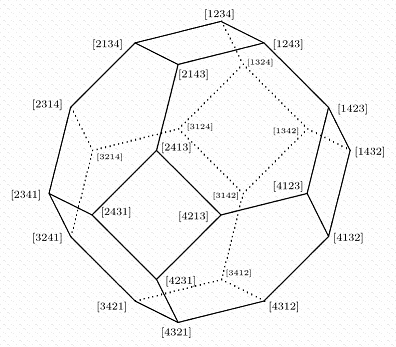
… "icy white and crystalline" — Johnny Mercer
From a search in this journal for Hudson Hawk —

See also Stella Octangula.
Peter Galison, a Harvard professor, is a defender of
the Vienna Circle and the religion of Scientism.
From Galison's “Structure of Crystal, Bucket of Dust,” in
Circles Disturbed: The Interplay of Mathematics and Narrative ,
edited by Apostolos Doxiadis and Barry Mazur, pp. 52-78
(Princeton: Princeton U. Press, 2012) …
Galison's final paragraph —
"Perhaps, then, it should not surprise us too much if,
as Wheeler approaches the beginning-end of all things,
there is a bucket of Borelian dust. Out of this filth,
through the proposition machine of quantum mechanics
comes pregeometry; pregeometry makes geometry;
geometry gives rise to matter and the physical laws
and constants of the universe. At once close to and far
from the crystalline story that Bourbaki invoked,
Wheeler’s genesis puts one in mind of Genesis 3:19:
'In the sweat of thy face shalt thou eat bread, till thou
return unto the ground; for out of it wast thou taken:
for dust thou art, and unto dust shalt thou return.' "
For fans of Scientism who prefer more colorful narratives —

A book by Northrop Frye pictured in the previous post
suggests a Log24 search for "The Great Code."
That search yields …
"Icy white and crystalline"
— Johnny Mercer
Backstory: Verhexung and Ein Kampf .
Prequel: The Verhexung quote above is from Wittgenstein's section 109
in Philosophical Investigations . The search result shown links to a page
containing part of the preceding Wittgenstein section —

For another look at "crystalline purity" and language, see the previous
two posts, Logic and Fruit Loom.
Wallace Stevens, “Country Words” —
“What is it that my feeling seeks?
I know from all the things it touched
And left beside and left behind.
It wants the diamond pivot bright.”
Continued from yesterday.
The passage on Claude Chevalley quoted here
yesterday in the post Dead Reckoning was, it turns out,
also quoted by Peter Galison in his essay "Structure of Crystal,
Bucket of Dust" in Circles Disturbed: The Interplay of
Mathematics and Narrative (Princeton University Press, 2012,
ed. by Apostolos Doxiadis and Barry Mazur).
Galison gives a reference to his source:
"From 'Claude Chevalley Described by His Daughter (1988),'
in Michèle Chouchan, Nicolas Bourbaki: Faits et légendes
(Paris: Éditions du Choix, 1995), 36–40, translated and cited
in Marjorie Senechal, 'The Continuing Silence of Bourbaki:
An Interview with Pierre Cartier, June 18, 1997,'
Mathematical Intelligencer 1 (1998): 22–28."
Galison's essay compares Chevalley with the physicist
John Archibald Wheeler. His final paragraph —
"Perhaps, then, it should not surprise us too much if,
as Wheeler approaches the beginning-end of all things,
there is a bucket of Borelian dust. Out of this filth,
through the proposition machine of quantum mechanics
comes pregeometry; pregeometry makes geometry;
geometry gives rise to matter and the physical laws
and constants of the universe. At once close to and far
from the crystalline story that Bourbaki invoked,
Wheeler’s genesis puts one in mind of Genesis 3:19:
'In the sweat of thy face shalt thou eat bread, till thou
return unto the ground; for out of it wast thou taken:
for dust thou art, and unto dust shalt thou return.'"
See also posts tagged Wheeler.
Friday evening’s post Musement dealt with Iris Murdoch’s
phrase “the clean crystalline work.”
For dirty bloody work see the life of Don Reitz, who
reportedly died at 84 on March 19.

(The title is from a work by Charles Sanders Peirce.)
For LYNX 760 —
For more beauty and strangeness, see Strange McEntire.
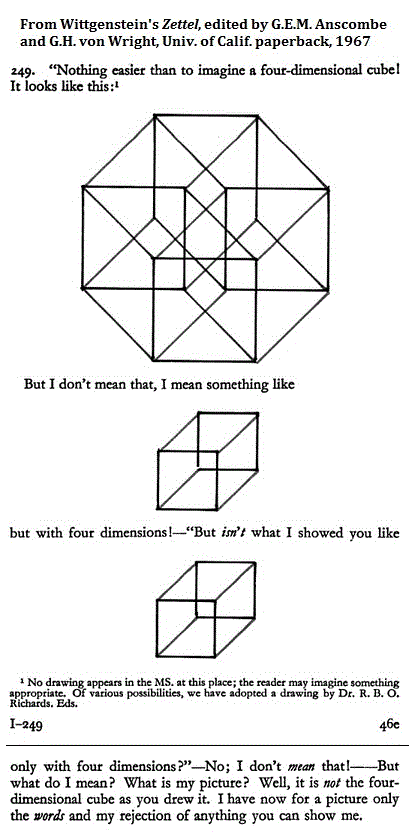
See also last night's "Pink Champagne on Ice" post.
The "ice" in that post's title refers to the white lines
forming a tesseract in the book cover's background—
"icy white and crystalline," as Johnny Mercer put it.
(A Tune for Josefine, Nov. 25.)
See also the tag Diamond Theory tesseract in this journal.
From the New York Times obituary of philanthropist
Fred Kavli, who died on Thursday, November 21—
” In 2005, when Mr. Kavli announced that
he planned to start the prizes, he recalled
skiing in the Norwegian mountains as a boy.
‘At times,’ he told a gathering in New York,
‘the whole sky was aflame with the Northern Lights
shifting and dancing across the sky down to the
white-clad mountaintops. In the stillness and
loneliness of the white mountains, I pondered the
universe, the planet, nature and the wonders of
man. I’m still pondering.’ “
“And we may see the meadow in December, icy white
and crystalline….” — Johnny Mercer, lyrics to Lionel
Hampton and Sonny Burke’s “Midnight Sun”
* Lyche
"… Reality is not a given whole. An understanding of this,
a respect for the contingent, is essential to imagination
as opposed to fantasy. Our sense of form, which is an
aspect of our desire for consolation, can be a danger to
our sense of reality as a rich receding background.
Against the consolations of form, the clean crystalline
work, the simplified fantasy-myth, we must pit the
destructive power of the now so unfashionable naturalistic
idea of character.
Real people are destructive of myth, contingency is
destructive of fantasy and opens the way for imagination.
Think of the Russians, those great masters of the contingent.
Too much contingency of course may turn art into journalism.
But since reality is incomplete, art must not be too much
afraid of incompleteness. Literature must always represent a
battle between real people and images; and what it requires
now is a much stronger and more complex conception of the
former."
— Iris Murdoch, January 1961, "Against Dryness"
“And we may see the meadow in December,
icy white and crystalline” — Johnny Mercer
“At another end of the sexual confusion spectrum….”
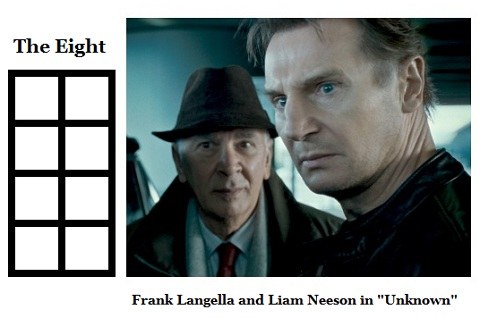
For Emil Artin—
“And we may see
the meadow in December,
icy white and crystalline.”
— Johnny Mercer, “Midnight Sun”
An Adamantine View of "The [Philosophers'] Stone"
The New York Times column "The Stone" on Sunday, Nov. 21 had this—
"Wittgenstein was formally presenting his Tractatus Logico-Philosophicus , an already well-known work he had written in 1921, as his doctoral thesis. Russell and Moore were respectfully suggesting that they didn’t quite understand proposition 5.4541 when they were abruptly cut off by the irritable Wittgenstein. 'I don’t expect you to understand!' (I am relying on local legend here….)"
Proposition 5.4541*—
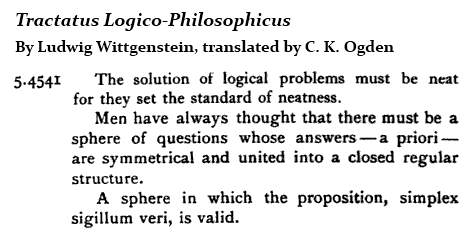
Related material, found during a further search—
A commentary on "simplex sigillum veri" leads to the phrase "adamantine crystalline structure of logic"—

For related metaphors, see The Diamond Cube, Design Cube 2x2x2, and A Simple Reflection Group of Order 168.
Here Łukasiewicz's phrase "the hardest of materials" apparently suggested the commentators' adjective "adamantine." The word "diamond" in the links above refers of course not to a material, but to a geometric form, the equiangular rhombus. For a connection of this sort of geometry with logic, see The Diamond Theorem and The Geometry of Logic.
For more about God, a Stone, logic, and cubes, see Tale (Nov. 23).
* 5.4541 in the German original—
Die Lösungen der logischen Probleme müssen einfach sein,
denn sie setzen den Standard der Einfachheit.
Die Menschen haben immer geahnt, dass es
ein Gebiet von Fragen geben müsse, deren Antworten—
a priori—symmetrisch, und zu einem abgeschlossenen,
regelmäßigen Gebilde vereint liegen.
Ein Gebiet, in dem der Satz gilt: simplex sigillum veri.
Here "einfach" means "simple," not "neat," and "Gebiet" means
"area, region, field, realm," not (except metaphorically) "sphere."
"Edward T. Hall, a cultural anthropologist
who pioneered the study of nonverbal
communication and interactions between
members of different ethnic groups,
died July 20 at his home in
Santa Fe, N.M. He was 95."
NY Times piece quoted here on
the date of Hall's death:
|
"July 20, 1969, was the moment NASA needed, more than anything else in this world, the Word. But that was something NASA's engineers had no specifications for. At this moment, that remains the only solution to recovering NASA's true destiny, which is, of course, to build that bridge to the stars." Commentary — |
"Mr. Hall first became interested in
space and time as forms of cultural
expression while working on
Navajo and Hopi reservations
in the 1930s."
Log24, July 29:
|
"Kaleidoscope turning…
Shifting pattern within |
"We are the key."
— Eye of Cat
Paul Newall, "Kieślowski's Three Colours Trilogy"—
"Julie recognises the music of the busker outside playing a recorder as that of her husband's. When she asks him where he heard it, he replies that he makes up all sorts of things. This is an instance of a theory of Kieślowski's that 'different people, in different places, are thinking the same thing but for different reasons.' With regard to music in particular, he held what might be characterised as a Platonic view according to which notes pre-exist and are picked out and assembled by people. That these can accord with one another is a sign of what connects people, or so he believed."
The above photo of Juliette Binoche in Blue accompanying the quotations from Zelazny illustrates Kieślowski's concept, with graphic designs instead of musical notes. Some of the same designs are discussed in Abstraction and the Holocaust (Mark Godfrey, Yale University Press, 2007). (See the Log24 entries of June 11, 2009.)
Related material:
"Jeffrey Overstreet, in his book Through a Screen Darkly, comments extensively on Blue. He says these stones 'are like strands of suspended crystalline tears, pieces of sharp-edged grief that Julie has not been able to express.'….
Throughout the film the color blue crops up, highlighting the mood of Julie's grief. A blue light occurs frequently, when Julie is caught by some fleeting memory. Accompanied by strains of an orchestral composition, possibly her husband's, these blue screen shots hold for several seconds while Julie is clearly processing something. The meaning of this blue light is unexplained. For Overstreet, it is the spirit of reunification of broken things."
— Martin Baggs at Mosaic Movie Connect Group on Sunday, March 15, 2009. (Cf. Log24 on that date.)
For such a spirit, compare Binoche's blue mobile in Blue with Binoche's gathered shards in Bee Season.
Quoted here
a year ago today:
“… she explores
the nature of identity
in a structure of
crystalline complexity.”
— Janet Burroway
(See ART WARS.)
Related material:

Amy Adams in Doubt

Amy Adams and Meryl Streep
at premiere of Doubt

Above:
Craft, 1999
“The matron had given her
leave to go out as soon as
the women’s tea was over….”
— James Joyce, “Clay”

“Leonard Mlodinow has had, to speak informally, a pretty random career….
A far more sober instance of randomness, however, underpins his new book, The Drunkard’s Walk. And it’s not hard to see it as a sort of Rosebud, explaining why the author finds unpredictability so compelling.”
Another sort of Rosebud–
C. P. Snow on G. H. Hardy:
“… A Mathematician’s Apology is, if read with the textual attention it deserves, a book of haunting sadness. Yes, it is witty and sharp with intellectual high spirits: yes, the crystalline clarity and candour are still there: yes, it is the testament of a creative artist. But it is also, in an understated stoical fashion, a passionate lament for creative powers that used to be and that will never come again.”
Perhaps in the afterlife Hardy, an expert on the theory of numbers, does again enjoy such powers. If so, his comments on the following would be of interest:
2 + 3 + 5 + 7 + 11 +
13 + 17 + 19 + 23 +
29 + 31 + 37 + 41 +
43 + 47 + 53 + 59 +
61 + 67 = 568
See The On-Line Encyclopedia
of Integer Sequences,
A046731, Sum of primes < 10^n, as well as
A006880, Number of primes < 10^n.
According to an amateur* mathematician named Cino Hilliard, “a very important relationship exists” between the sum of primes less than x and the prime counting function Pi(x) which is the number of primes less than x—
Whether this apparent relationship is, in fact, “very important,” or merely a straightforward consequence of other number-theoretical facts, is not obvious (to those of us not expert in number theory) from Google searches. Perhaps Hardy can clear this question up for those who will, by luck or grace, meet him in the next world.
* For some background, see a profile and user group messages here and here and here.
"Hancock" Powers to the Top
of July Fourth Box Office
— This evening's online
New York Times
|
New York Lottery
Sunday, July 6, 2008:
Mid-day 307
Evening 921 |
|
Symbols:
|
|
"The consolations of form,
the clean crystalline work"
— Iris Murdoch,
"Against Dryness" |
Will Smith
on Chess

Will Smith
"A devoted father, Smith passes on his philosophy of life to his children through chess, among other things.
'My father taught me how to play chess at seven and introduced beautiful concepts that I try to pass on to my kids. The elements and concepts of life are so perfectly illustrated on a chess board. The ability to accurately assess your position is the key to chess, which I also think is the key to life.'
He pauses, searching for an example. 'Everything you do in your life is a move. You wake up in the morning, you strap on a gun, and you walk out on the street– that's a move. You've made a move and the universe is going to respond with its move.
'Whatever move you're going to make in your life to be successful, you have to accurately access the next couple of moves– like what's going to happen if you do this? Because once you've made your move, you can't take it back. The universe is going to respond.'
Smith has just finished reading The Alchemist, by the Brazilian writer Paulo Coelho: 'It says the entire world is contained in one grain of sand, and you can learn everything you need to learn about the entire universe from that one grain of sand. That is the kind of concept I'm teaching my kids.'"
Stevie Nicks
is 60 today.
On the author discussed
here yesterday,
Siri Hustvedt:
“… she explores
the nature of identity
in a structure* of
crystalline complexity.”
— Janet Burroway,
quoted in
ART WARS


“Is it safe?”
— Annals of Art Education:
Geometry and Death
* Related material:
the life and work of
Felix Christian Klein
and
Report to the Joint
Mathematics Meetings

Click on image
for details.

“The alternative to ‘crystalline closure’
is not, then, an endless and chaotic
‘repetition and proliferation,’ but a
*structured relationship of significance.”
— The Old New Criticism and Its Critics,
by R. V. Young, Professor of English
at North Carolina State University
— Iris Murdoch
"The consolations of form,
the clean crystalline work"
— Iris Murdoch,
"Against Dryness"
"As a teacher Quine
was carefully organized,
precise, and conscientious,
but somewhat dry
in his classroom style."
Word:

Object:
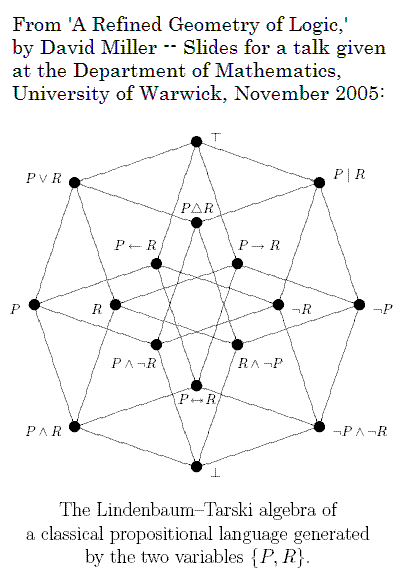
Myth and Story:
The five entries ending
on Jan. 27, 2007
"There is such a thing
as a tesseract."
— Madeleine L'Engle
Kerry
"They told me that you had
gone totally insane and that
your methods were unsound."
Bush
"Are my methods unsound?"
Kerry
"I don't see
any method at all, sir."

Karl Rove
"Perfect, genuine,
complete, crystalline, pure."
— From page 2 of
Problems of Mysticism
and Its Symbolism, by
Herbert Silberer, 1914
(English translation
published in 1917)
“And we may see
the meadow in December,
icy white and crystalline.”
— Johnny Mercer,
“Midnight Sun“
— Silberer, Problems of Mysticism online
“Since thirty mornings
are required to make
A day of which we say,
this is the day
That we desire, a day of
blank, blue wheels,
Involving the four corners
of the sky,
Lapised and lacqued
and freely emeraldine
In the space it fills,
the silent motioner
There, of clear, revolving
crystalline;
Since thirty summers
are needed for a year
And thirty years,
in the galaxies of birth,
Are time for counting
and remembering….”
— Wallace Stevens,
“Of Ideal Time and Choice,”
in The Necessary Angel, 1951
“When it’s time to railroad,
people start railroading.”
— Robert A. Heinlein in
The Door into Summer, 1957
“Everybody’s doin’
a brand new dance now…”
— Kylie Minogue, 1987-88
Happy birthday, Kylie.
“Heaven– Where Is It?
How Do We Get There?”
To air on ABC
Tuesday, Dec. 20
(John Spencer’s birthday)
“And we may see
the meadow in December,
icy white and crystalline.”
The Meadow
"Heaven– Where Is It?
How Do We Get There?"
To air on ABC
Tuesday, Dec. 20
(John Spencer's birthday)
By Trevanian, who died on
Wednesday, Dec. 14, 2005:
|
From
Shibumi "Well… the flow of the play was just right, and it began to bring me to the meadow. It always begins with some kind of flowing motion… a stream or river, maybe the wind making waves in a field of ripe rice, the glitter of leaves moving in a breeze, clouds flowing by. And for me, if the structure of the Go stones is flowing classically, that too can bring me to the meadow." "The meadow?" "Yes. That's the place I expand into. It's how I recognize that I am resting." "Is it a real meadow?" "Yes, of course." "A meadow you visited at one time? A place in your memory?" "It's not in my memory. I've never been there when I was diminished." "Diminished?" "You know… when I'm in my body and not resting." "You consider normal life to be a diminished state, then?" "I consider time spent at rest to be normal. Time like this… temporary, and… yes, diminished." "Tell me about the meadow, Nikko." "It is triangular. And it slopes uphill, away from me. The grass is tall. There are no animals. Nothing has ever walked on the grass or eaten it. There are flowers, a breeze… warm. Pale sky. I'm always glad to be the grass again." "You are the grass?" "We are one another. Like the breeze, and the yellow sunlight. We're all… mixed in together." "I see. I see. Your description of the mystic experience resembles others I have read. And this meadow is what the writers call your 'gateway' or 'path.' Do you ever think of it in those terms?" "No." "So. What happens then?" "Nothing. I am at rest. I am everywhere at once. And everything is unimportant and delightful. And then… I begin to diminish. I separate from the sunlight and the meadow, and I contract again back into my bodyself. And the rest is over." Nicholai smiled uncertainly. "I suppose I am not describing it very well, Teacher. It's not… the kind of thing one describes." "No, you describe it very well, Nikko. You have evoked a memory in me that I had almost lost. Once or twice when I was a child… in summer, I think… I experienced brief transports such as you describe. I read once that most people have occasional mystic experiences when they are children, but soon outgrow them. And forget them…." |
"And we may see
the meadow in December,
icy white and crystalline."
"In Francis Ford Coppola's film, Col. Kurtz tells how after his medics inoculated a small village, the Reds chopped off every child's left arm. 'My God, the genius of that. The genius,' Kurtz said. 'The will to do that. Perfect, genuine, complete, crystalline, pure! And then I realized they were stronger than me because they could stand it.'"
— Col. David Hackworth
on Tuesday, April 9, 2002.
Col. Hackworth died at 74
on Wednesday, May 4, 2005.

|
|
Mies van der Rohe:
Mies in Berlin

Winner of
The Society of Architectural Historians
2002 Philip Johnson Award
for Excellence
Exhibition Catalog
"It would have been wiser for the new MoMA catalog… to have addressed the issue of his politics…. By ignoring such a central subject… the show gives off a mild stench of cover-up…. Only the German-born Rosemarie Haag Bletter (full disclosure: she is my wife) alludes to the verboten topic in her [catalog] essay on Mies's flirtation with crystal imagery, drawing a sharp parallel between the architect's extensive use of Kristallglas (plate glass) and the ensuing devastation of Kristallnacht, which erupted just three months after he left for the States."
"Mies's rigorously simplified structures, typified by grids of steel and glass and an absence of applied ornament, represented the Platonic ideal of modernism for many people."

and Version B,

from the date of Johnson's death
at his "famous crystalline box."
Was less more?
Today's Sermon:
Canonization
The title of Cleanth Brooks's classic The Well Wrought Urn comes from a poem by John Donne:
We’ll build in sonnets pretty roomes;
As well a well wrought urne becomes
The greatest ashes, as half-acre tombes.
"A poem cannot exhaust reality, but it can arrest it: by manifesting a vision of experience available in no other way. This is only possible because, like a physical urn, it is a distinct substantial object: only by its difference from human experience can a poem represent that experience, even as the urn can be a metaphor for a poem only if it is not itself a poem. The alternative to 'crystalline closure' is not, then, an endless and chaotic 'repetition and proliferation,' but a structured relationship of significance."
— The Old New Criticism and Its Critics, by R. V. Young, Professor of English at North Carolina State University
Related reading: At War with the Word, by R. V. Young.
"A musical composition in which the voices begin one after another, at regular intervals, successively taking up the same subject. It either winds up with a coda (tailpiece), or, as each voice finishes, commences anew, thus forming a perpetual fugue or round." — Webster's Revised Unabridged Dictionary
Canonization:
The process of making a musical theme into a canon:
"The phrase continues almost uninterrupted and unvaried until the canonization of the theme…."
— Program Notes for
Greater Dallas Youth Orchestras,
Sunday May 18, 2003, by Erin Lin
on Symphony No. 3 in C Minor, Op. 78,
by Camille Saint-Saëns
For more on this concept, see the Log24.net entries of July 16-31, 2004, and in particular the entries of July 25.
See, too, Theme and Variations, with its midi of Bach's
Fourteen Canons on the First Eight Notes of the Goldberg Ground.
ART WARS:
Art at the Vanishing Point
Two readings from The New York Times Book Review of Sunday,
2003 are relevant to our recurring "art wars" theme. The essay on Dante by Judith Shulevitz on page 31 recalls his "point at which all times are present." (See my March 7 entry.) On page 12 there is a review of a novel about the alleged "high culture" of the New York art world. The novel is centered on Leo Hertzberg, a fictional Columbia University art historian. From Janet Burroway's review of What I Loved, by Siri Hustvedt:
"…the 'zeros' who inhabit the book… dramatize its speculations about the self…. the spectator who is 'the true vanishing point, the pinprick in the canvas.'''
Here is a canvas by Richard McGuire for April Fools' Day 1995, illustrating such a spectator.

For more on the "vanishing point," or "point at infinity," see
Connoisseurs of ArtSpeak may appreciate Burroway's summary of Hustvedt's prose: "…her real canvas is philosophical, and here she explores the nature of identity in a structure of crystalline complexity."
For another "structure of crystalline
complexity," see my March 6 entry,
For a more honest account of the
New York art scene, see Tom Wolfe's
The Painted Word.
The Cruciatus Curse
Today’s birthday — Martin Sheen
 Perfect, genuine, complete, crystalline, pure.
Perfect, genuine, complete, crystalline, pure.
Powered by WordPress